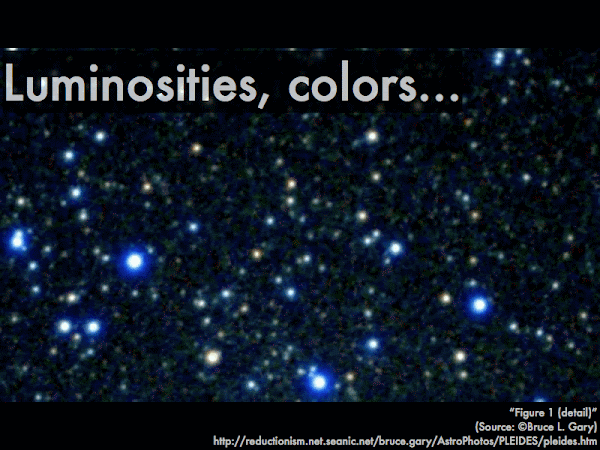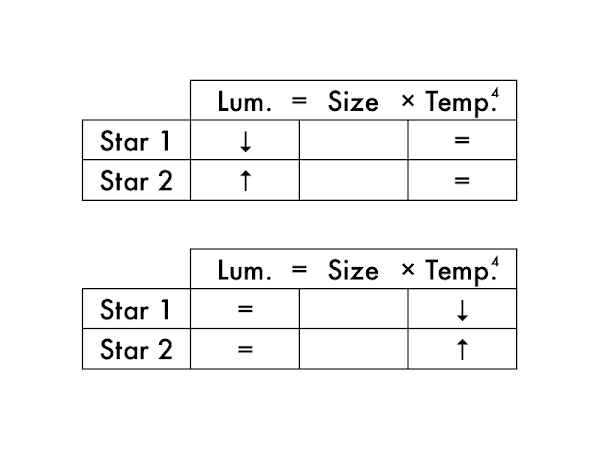Cuesta College, San Luis Obispo, CA
Students have a weekly online reading assignment (hosted by SurveyMonkey.com), where they answer questions based on reading their textbook, material covered in previous lectures, opinion questions, and/or asking (anonymous) questions or making (anonymous) comments. Full credit is given for completing the online reading assignment before next week's lecture, regardless if whether their answers are correct/incorrect. Selected results/questions/comments are addressed by the instructor at the start of the following lecture.
The following questions were asked on reading textbook chapters and previewing presentations on parallax, distance, apparent magnitude, absolute magnitude, Wien's law and the Stefan-Boltzmann law, and a TED-Ed talk on stellar properties.

Selected/edited responses are given below.
Describe something you found interesting from the assigned textbook reading or presentation preview, and explain why this was personally interesting for you.
"I like the idea of using parallax to determine distance of objects in the sky."
"It was cool learning about the differences in absolute and apparent magnitudes."
"Apparent magnitude and absolute magnitude are interesting. A star that is closer may appear as being very bright but if it is moved 10 parsecs away, it will get dimmer."
"When watching Star Wars, I had no idea what a 'parsec' was but I learned that it's the distance to an imaginary star that has a 'parallax of 1 arc second.' So now I know what Han Solo meant when he said he made the Kessel Run in 12 parsecs, which I found pretty interesting and cool."
"Blackbody radiation is interesting. That we as humans emit (infrared) light from our body heat is very cool."
"Blackbody radiation and finding the size of a star through its luminosity and color was pretty interesting."
"How colors correspond to temperature. This was interesting because it would be assumed that blue means cold but it is actually quite the opposite."
"Based on the color and intensity of light we can determine the size of an object. The deduction here seems pretty basic, but makes a ton of sense."
"I found the different colors of hotness to be interesting, because in my mind red is the hottest because of fires and things like that."
Describe something you found confusing from the assigned textbook reading or presentation preview, and explain why this was personally confusing for you.
"I don't understand the difference the magnitude scale and the difference between apparent and absolute magnitude."
"The method of determining the distance of a star."
"The concept of parsecs. I really need to get some guidance on this when we have class next. I don't know how to understand the info I am receiving."
"The whole idea of measuring a parsec and a stellar parallax."
"I think the brightness scale is confusing."
"Telling which star is the brightest or dimmest."
"Everything. the distances, numbers, parsecs, magnitudes, temperatures--there's a lot..."
"The math equations are a little confusing."
"The Stefan-Boltzmann law."
"Something I found kind of confusing and could use a little bit more lecture on is the Hertzsprung-Russell (H-R) diagram. I think I understand the basics, but I'm also a little confused by it at the same time."
Explain how apparent magnitude and the absolute magnitude are defined differently.
"Apparent magnitude is the measure of the brightness of a star as seen from Earth; while absolute magnitude is the measure of the brightness of a star seen from 10 parsecs away."
"Apparent magnitude is how bright it looks from Earth, and absolute magnitude is how bright the star appears at a standardized distance of 10 parsecs."
"Absolute magnitude is general brightness, apparent is brightness from its location."
"Absolute magnitude factors in the star's distance to Earth when looking at it, while apparent magnitude does not."
"I will know this by tomorrow I promise!"
Suppose the sun was moved to a distance of 10 parsecs away. As a result, its __________ magnitude would become dimmer.
absolute. [6] apparent. ***************** [17] (Both of the above choices.) ** [2] (Neither of the above choices.) * [1] (Unsure/guessing/lost/help!) * [1]

(Only correct responses shown.)
1 (brightest): the sun, m = –27 [74%]
2: Canopus, m = –1 [67%]
3: Vega, m = 0 [70%]
4 (dimmest): Kapteyn's star, m = +9 [78%]
Rank the brightnesses of these stars (1 = brightest, 4 = dimmest; there are no ties), if relocated to 10 parsecs from Earth.
(Only correct responses shown.)
1 (brightest): Canopus, M = –3 [63%]
2: Vega, M = +0.5 [67%]
3: the sun, M = +5 [67%]
4 (dimmest): Kapteyn's star, M = +11 [74%]
Determine whether these stars get dimmer or brighter when relocated from their original positions to 10 parsecs from Earth.
(Only correct responses shown.)
The sun: gets dimmer [81%]
Canopus: gets brighter [74%]
Vega: gets dimmer [33%]
Kapteyn's star: gets dimmer [41%]
Rank the temperatures of these main sequence stars (1 = hottest, 4 = coolest; there are no ties).
(Only correct responses shown.)
Hottest: blue main sequence star [67%]
Second hottest: white main sequence star [89%]
Third hottest: yellow main sequence star [70%]
Coolest: red main sequence star [89%]
Rank the temperatures of these supergiant and dwarf stars (1 = hottest, 4 = coolest; there are no ties).
(Only correct responses shown.)
Hottest: blue supergiant [63%]
Second hottest: white dwarf [63%]
Third hottest: yellow supergiant [67%]
Coolest: red dwarf [70%]

dimmer. **** [4] brighter. ********** [20] (These stars would be the same size.) * [1] (Unsure/guessing/lost/help!) ** [2]
Two stars (equally far away) have the same brightness, but one star is cooler, and the other star is hotter. The __________ star will be larger in size.
cooler. *************** [15] hotter. ******** [8] (These stars would be the same size.) ** [2] (Unsure/guessing/lost/help!) ** [2]
Ask the instructor an anonymous question, or make a comment. Selected questions/comments may be discussed in class.
"Please help me with parsecs."
"The book mentions the 'intrinsic brightness' of a star. Is this similar to the absolute magnitude?" (Yes, both are ways of measuring the "true" brightnesses of stars.)
"What's the hardest thing for you to teach in this class?" (After the first midterm, the stuff we're covering this week: apparent/absolute magnitudes, and Wien/Stefan-Boltzmann laws.)
"Does an Earth-type planet that is capable of sustaining life have to orbit another star that is the same as ours?" (Well, maybe a medium-mass star like our sun, but also maybe a low-mass star like a red dwarf. As we'll see later this semester, it is not likely that an Earth-like planet around a massive star would be capable of sustaining life, due to the very short lifetime of the massive star.)
"Really random question: what happens if you landed near the Milky Way? Will you die?" (Our solar system is located in the Milky Way, which is our own galaxy.)
"Will you be reading some of these questions in class anytime soon?" (Sometimes, although part of the weekly online reading assignments is for you to read through the answers to these questions.)
"I swear I read the textbook! Just not in time for the reading assignments, I guess..."
"Coffee or tea?" (Coffee.)
No comments:
Post a Comment